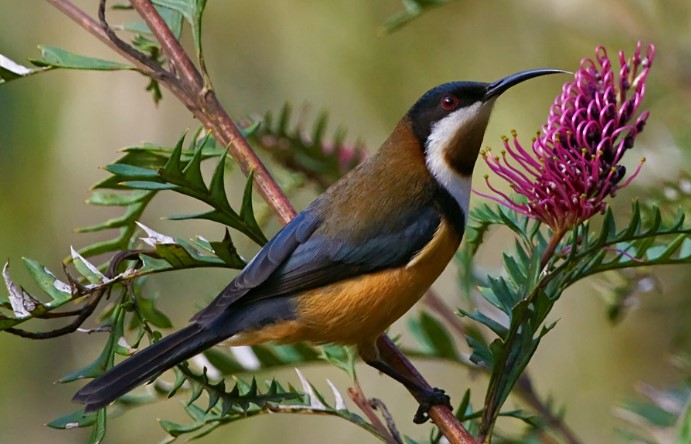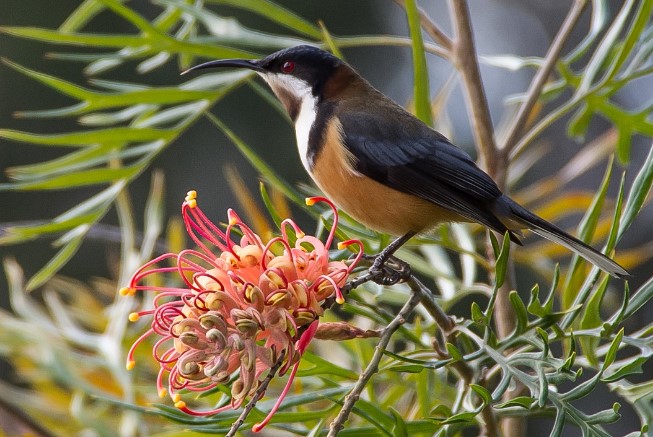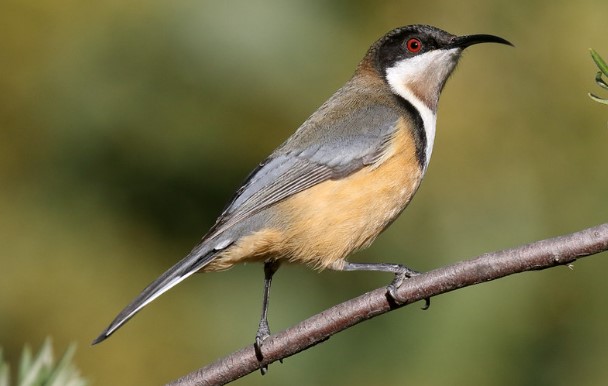The Eastern Spinebill is a small honeyeater with particularly long bills for probing tubular flowers for nectar. It is also known as Cobbler’s Awl or Spine-billed Honeyearer. Additionally, their long, protruding tongues are tipped with short serrations, which are better suited for licking and capillary flow than brushing.
The Eastern Spinebill used this organ effectively in wet shrubberies around eastern Australia. They eat insects and feed their young almost exclusively on them for protein, but they rely largely on nectar for their own survival. Sclerophyll forests, scrub, and heathlands are the habitats of eastern spinebills. Urban gardens with sufficient vegetation can provide them with cover and food, making them ideal for urban gardens.

Eastern Spinebill calls with rapid, repeated piping whistles on the same pitch, in bursts, to indicate contact and position. Spinebills sing quick, three-syllable twittered whistles, pi-pi-dee, pi-pi-dee, in cyclic bursts, from perch, and in flight. Eastern Spinebills measure approximately 150-160 mm, including their bill, which measures 30 mm. Eastern Spinebills sometimes hover for nectar from flowers as if they were hummingbirds. Honeyeaters usually perch on flowers to feed on them. Moreover, Western Spinebill replace him in southwestern Australia’s scrubby woodlands and heathlands.
Their wintering habitats are lowlands in the southern mountains, where they often enter urban gardens. Coastal and northern localities are sedentary, but southern mountains are more mobile. A few meters from the ground, the birds forage in shrubs in forest understorey and in taller heaths at times of flowering. Their wings whirl noisily as they glide between flowering shrubs in zigzag undulations, tails flirting and flashing white as they flutter about nonstop.
Among the most commonly visited flowers are epacrids, Correa, Banksia, Billardiera, and eucalypts. Breeding males defend small territories with wavering climbing song-flights while females build nests and incubate them. The male may also bring nest materials and relieve at times in incubation; later, he may assist with feeding.
Read More – Melodies of Nature: Captivating Song Thrush Sound That Will Enchant Your Soul

In August-March, nesting and breeding take place, with October-January being the peak time. There is a nest made of grasses and plant fibers, lined with feathers or hair and attached to twigs 1-5 meters above ground in bushy shrubs or trees. There is a low whirring sound produced by the Eastern Spinebill’s flight. The outer white tail feathers are also a wonderful sight to see.
A male’s crown, sides, and underside of the head are glossy black; the collar is russet, grading to grey-brown on the back, and the rump is grey. The wings and tail are glossy black, with broad white tips on the outer tail feathers. A deep chestnut brown patch covers the center of the throat. Throat and breast are white, flanked by broad black crescents. It has tawny rufous underparts. The eyes are crimson in color. Black is the color of the bill and feet.
Read More – Are Dracula Parrots Real?

FEMALE: As male but the crown is satin grey. A mature adult’s upper parts are plain olive brown; the throat is cream and the belly is tawny. The eyes are browner. There may be periods when nectar production is low during periods of abundant flowering, and it appears that the eastern spinebill responds by storing fat during periods of high nectar production, by feeding more frequently, or by lowering their metabolic rate during the day.
The Eastern Spinebill lays two or three buff or buff-pink eggs with chestnut or red-brown spots at the larger end. Eggs measure about 17 x 13 mm and are oval-shaped. It takes about 13-14 days for the female to incubate. The chicks are fed by both parents, and the fecal sacs are removed from the nest. From Cooktown, Queensland, south to Tasmania, Mt Lofty Ranges, and Kangaroo Island, SA, the Eastern Spinebill can be found on tablelands inland. Four races exist.
Read More – Spiny-cheeked Honeyeater – A Bird Like No Other







